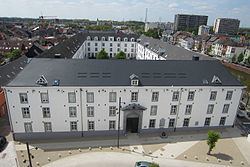Other names SS-Sammellager Mecheln Original use Military barracks First built 1756 | ||
 | ||
Operated by Nazi GermanySicherheitspolizei (Sipo-SD) Operational July 1942 – September 1944 Operators | ||
The Mechelen transit camp, officially SS-Sammellager Mecheln in German, was a detention and deportation camp established in the former Dossin Barracks at Mechelen in German-occupied Belgium. The transit camp was run by the Sicherheitspolizei (SiPo-SD), a branch of the SS-Reichssicherheitshauptamt, in order to collect and deport Jews and other minorities such as Romani mainly out of Belgium towards the labor camp of Heydebreck-Cosel and the concentration camps of Auschwitz-Birkenau in German occupied Poland.
Contents
During the Second World War, between 4 August 1942 and 31 July 1944, 28 trains left from this Belgian casern and deported over 25,000 Jews and Roma, most of whom arrived at the extermination camps of Auschwitz-Birkenau. At the end of war, 1240 of them had survived.
Since 1996, a Holocaust museum has been open near the site of the camp: the Kazerne Dossin – Memorial.
Location
In the summer of 1942, the Nazis made preparations to deport the Jews of German-occupied Belgium, of which about 90 percent lived in the cities of Antwerp and Brussels. Mechelen, a city with a major railway hub that ensured easy transport, was located nearly halfway between the two cities. A track that connected a local freight dock ran along the River Dijle bypass at the inner city's ring road, where the rails passed a former Belgian army barracks, named Dossin Barracks (Caserne Dossin) after Lieutenant-General Émile Dossin de Saint-Georges. In the First World War, the division led by General Emile Dossin had put up a brave defense near the River Yser, including at a place named St.-Georges. In recognition, the general received the title Baron de Saint-Georges. At his death in 1936, the old barracks at Mechelen was renamed in his honour. The Germans found this location with minor adaptions required ideal for a transit camp in their Endlösung programme.
Operation
The three-storey block that completely surrounded a large square yard was fitted with barbed wire. The camp staff was mostly German but was assisted by Belgian collaborationists from the Algemeene-SS Vlaanderen ("General SS Flanders"). It was officially under the command of Philipp Schmitt, commandant of the prison camp at Breendonk. The acting commandant at Mechelen was SS officer Rudolph Steckmann.
The first group of people arrived in the camp from Antwerp on 27 July 1942. Between August and December 1942, two transports, each with about 1,000 Jews, left the camp every week for Auschwitz concentration camp. Between the 4 August 1942 and 31 July 1944, a total of 28 trains left Mechelen for Poland, carrying 24,916 Jews and 351 Roma; most of them went to Auschwitz. This figure represented more than half of the Belgian Jews murdered during the Holocaust. In line with the Nazi racial policy that much later became named the Porajmos (or Samudaripen), 351 Belgian Roma were sent to Auschwitz in early 1944.
Conditions at the Mechelen camp were especially brutal. Many Roma were locked in basement rooms for weeks or months at a time without food or sanitary facilities. The Roma had an especially low survival rate.
Confrontation
Some people succeeded in escaping the transports, especially from the 16th and 17th transport which consisted of men returned from forced labor on the Atlantic Wall to Belgium. Most of these men jumped between Mechelen and the German border. Many were caught and were soon put on subsequent transports but a total of about 500 Jewish prisoners did manage to escape from all the 28 transports. On April 19, 1943 three resistance fighters, acting on their own initiative, stopped the 20th transport near the train station of Boortmeerbeek, 10 kilometres (6.2 mi) south-east of Mechelen. From this action 17 prisoners managed to flee. More Jews escaped by their own deeds, a total of 231 Jews fled although 90 were eventually recaptured and 26 were shot by guards escorting the train.
The last transport left on 31 July 1944 but Allied forces could not stop it before its destination was reached. When the Allies approached Mechelen by 3 September 1944, the Germans fled the Dossin camp, leaving the 527 remaining prisoners behind. Some remaining prisoners escaped that night and the others were freed on the 4th, though soon replaced with suspected collaborators. The lists of deportees were left at Hasselt during the German retreat and were later discovered intact.
Memorial and Museum
From 1948 until it was abandoned in 1975, Dossin Barracks was again used by the Belgian Army. Apart from a wing renovated in the 1980s for social housing, the barracks became the site of the Jewish Museum of Deportation and Resistance by 1996. In 2001, the Flemish Government decided to expand the institution by a new complex opposite the old barracks; the latter closed in July 2011, to become a memorial monument. The Kazerne Dossin – Memorial, Museum and Documentation Centre on Holocaust and Human Rights reopened its doors on 26 November 2012.
